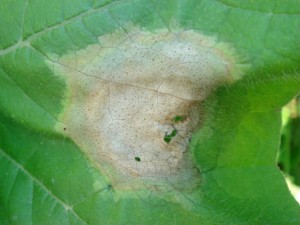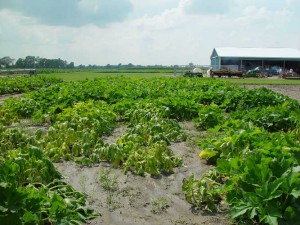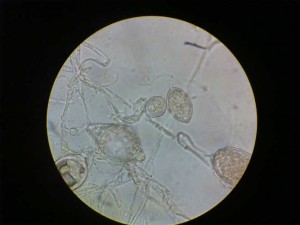What Is It? | Facts in Depth | For the Professional Diagnostician
Cucurbit Diseases | Phytophthora Blight
Phytophthora Blight
Identification
Phytophthora blight can affect all parts of cucurbit plants. In seedlings, P. capsici causes damping off, and roots and crowns of affected exhibit a watery, soft, light brown rot. P. capsici also causes root rots in mature plants. P. capsici affected root systems are small, discolored, have few feeder roots and the outer portion of the root can easily be pulled off the plant. Aboveground symptoms of Phytophthora blight include a brown discoloration of the crown and lower stem and foliar wilting. As the disease progresses, the stem becomes watersoaked, soft, and may collapse. Vines are also affected by P. capsici and brown, girdling lesions form on the vines and leaf petioles (these lesions begin as watersoaked areas). On leaves, P. capsici causes chlorotic to necrotic, irregularly shaped lesions that coalesce under disease conducive conditions. On fruit, symptoms begin as circular to irregularly shaped, watersoaked lesions. These lesions expand, coalesce, darken and depress slightly and become covered with dense, white-tan sporulation. Fruits can rot and collapse completely and this can occur in the field or post-harvest.



Pictures of infected cucumber plants (left), typical lesions on a pumpkin leaf (middle), and wilting of zucchini plants in a field (right).
Pathogen Biology
P. capsici is a heterothallic, oomycete that grows optimally at 77-83° F. Inoculum of P. capsici forms on all infected plant tissues. P. capsici spreads as either windborne sporangia or waterborne zoospores released from sporangia. Zoospores spread in irrigation water and flooded field areas. Oospores form in the presence of both mating types (A1 and A2). Oospores allow the pathogen to survive in the absence of a host and tolerate adverse conditions. The pathogen also overwinters as mycelium in infected crop debris.


Images of the different shaped sporangia of P. capsici.
Favorable Environmental Conditions
Disease conducive conditions for Phytophthora blight include warm (68-86° F), wet, waterlogged soils. These conditions allow for formation of sporangia and spread of zoospores. Warm and rainy conditions favor development of aboveground disease symptoms. Disease progression can be halted when soils become dry.
Often Confused With
- Damping off: Check roots microscopically for signs of other fungal or oomycete pathogens. Culturing may be necessary to identify cause of the damping off.
- Anthracnose: Check fruits for pink sporulation under high humidity. Leaf and stem lesions are smaller than Phytophthora blight lesions.
- Bacterial wilt: Slowly pull apart fresh cut stem to look for sticky strands of bacteria. There is no root discoloration associated with bacterial wilt.
- Fusarium wilt: Check for vascular discoloration in root and crown tissues. Rotted cortex cannot be easily pulled from stele.
- Bacterial fruit blotch: No white-tan, velvety sporulation will be observed on the fruit.
Scouting Notes
Fields with poorly drained soils and areas prone to flooding should be scouted for this disease. Disease is more common later in the season, when warmer temperatures are more conducive to disease. Even if soils are dry when scouting, symptoms can still be observed because this disease progresses very rapidly following waterlogging.
Thresholds
No thresholds have been established for this disease because it is best managed preventatively. Once symptoms begin, the disease is likely widespread in the field.
Management Notes
- Avoid excess water – Management of soil moisture levels is critical for managing this disease. Do not apply excess irrigation water. If possible, select well-drained soils and avoid planting in low lying areas. Avoid spreading the pathogen from infested fields to clean fields. Thoroughly clean and sanitize all equipment after leaving infested fields. Discard or destroy infected fruit away from production fields (do not make cull piles near fields).
- Rotate with non-host crops – A three year rotation can be used to reduce (but not eliminate) inoculum in infested fields. Solanaceous crops (tomato, eggplants, and pepper) are also susceptible to P. capsici, so these crops should be avoided in rotation with cucurbits.
- Start with fungicide-treated seed – Fungicide seed treatments can be used to prevent damping off, but no fungicide will eliminate the pathogen in soils. Foliar fungicide applications can be used to treat foliage and fruit infections. Fungicide treatments must be integrated with cultural management to see any reduction in disease. Current fungicide recommendations are found in the Midwest Vegetable Production Guide.
